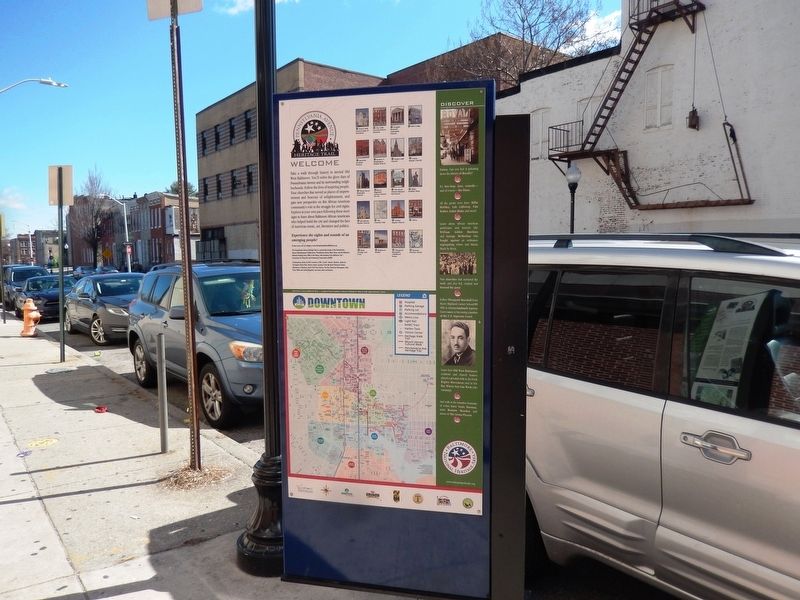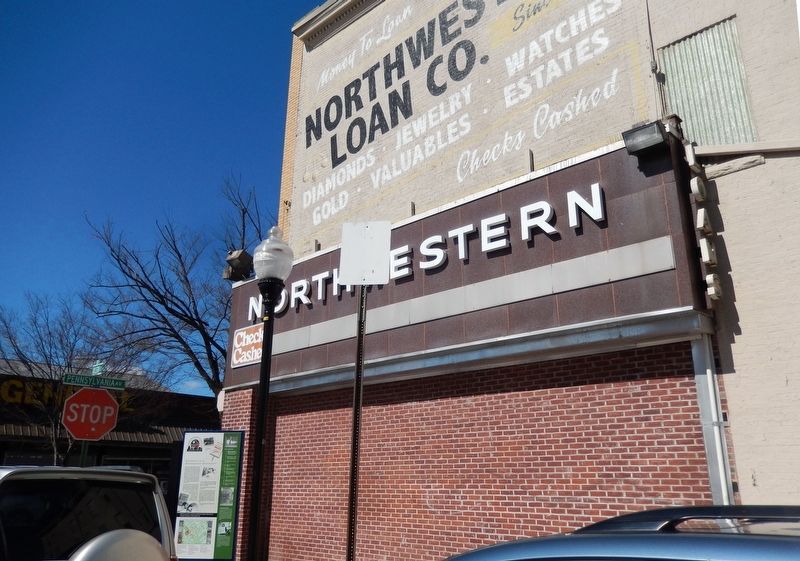Upton in Baltimore, Maryland — The American Northeast (Mid-Atlantic)
Diversity in a Segregated Community
Pennsylvania Avenue Heritage Trail
The sudden rise of Old West Baltimore’s premier African American community occurred on a foundation of diversity. Even though it was segregated from many white areas, it was still made up of a variety of people. African Americans from all backgrounds found refuge in Old West Baltimore. Stewards, chauffeurs, laborers and janitors lived side by side with teachers, physicians, lawyers and other professional men and women. Rental properties, boarding houses and owner-occupied homes sat next to one another, and Russians, Jews, and Italians lived in the community as well. This diversity helped nurture a civil rights mentality that spanned much of the 20th century.
African Americans fought to create this community in a city that tried to take it away. Antebellum African Americans in Baltimore set up employment bureaus, debating and literary societies, beneficial societies and schools. Many entrepreneurial African Americans built successful businesses, owned their homes and became church leaders. Meanwhile, Baltimore society worked to diminish the opportunities and successes of the African American communities. Throughout the 19th and early 20th centuries, dozens of federal, state and local laws diminishing the rights of African Americans passed through legislative bodies. Each time, progressive Baltimoreans fought against these racist policies.
The civil rights we enjoy today came from decades of persistent protest.
By the early 1960s, national organizations, like the NAACP and Congress of Racial Equality (CORE), helped raise civil rights to a national issue. Baltimore efforts worked in coordination with national leaders. After the successful efforts of the Buy Where You Can Work Campaign, in 1943 and interracial group met in Windsor Hills to form Baltimore’s Chapter of Congress for Racial Equality and the NAACP Baltimore Branch organized many protests from the 1930s through the 1960s.
The timeline at right touches on Baltimore’s fight for justice.
Baltimore Civil Rights Timeline
1789-Maryland Society for Promoting the Abolition of Slavery, and the Relief of Free Negroes, and Others, Unlawfully Held in Bondage formed.
1816-Baltimoreans, especially Daniel Coker, participate in the creation of the African Methodist Episcopal Church.
1825-Maryland Anti-slavery Society founded.
1885-Mutual Brotherhood of Liberty formed.
1906-Dr. Waring attends the founding of the Niagara Movement.
1908-Sharp Street holds annual meeting of the Niagara Movement Baltimore Chapter.
1911-NAACP Baltimore Branch formed.
1933-34-Buy Where You Can Work campaign demands jobs.
1943-Congress of Racial Equality leads sit-ins.
(Inscriptions
below the images on the right)
The Afro-American Newspapers
In 1892, former slave John H. Murphy founded the Afro-American Newspapers. Under his leadership and that of his son, Carl Murphy (1889-1967), the newspapers became a leading advocate for change and culture in the African American community. By 1945, the newspapers had a nationally weekly circulation of 235,000 and championed such causes as hiring blacks for fire and police departments and fighting the use of segregated Jim Crow cars on the Southern Railway.
Buy Where You Can Work
African American leaders, including future Supreme Court Justice Thurgood Marshall, Juanita Jackson Mitchell (daughter of Dr. Lillie Carroll Jackson) and Belford Vance Lawson, Jr. led a movement demanding jobs at locally owned stores that sold products to blacks but refused to hire them. In 1933, Lawson and Marshall took the fight all the way to the Supreme Court, where New Negro Alliance v. Sanitary Grocery Co. was won, guaranteeing the right to boycott.
Reverse Side of the Marker
Welcome
Take a walk through history in storied Old West Baltimore. You’ll relive the glory days of Pennsylvania Avenue and its surrounding neighborhoods. Follow the lives of inspiring people. Tour churches that served as places of empowerment and beacons of enlightenment, and gain new perspective on this African American community’s role in the struggle for civil rights. Explore at your own pace following these story signs to learn about Baltimore African Americans who helped build a city and changed the face of American music, art, literature and politics.
(Inscriptions under the images on the right)
1.Prince Hall Grand Lodge of Maryland
2.The Lillie Carroll Jackson Museum
3.Douglas Memorial Community Church
4.Elks Lodge
5.Morriah Keyhole Houses
6.Booker T. Washington Middle School
7.Bethel AME Church
8.Union Baptist Church
9.Sharp Street Methodist Church
10.Henry Highland Garnet School/PS 103
11.The Royal Theatre Marquee Monument
12.Billie Holiday Plaza
13.Macedonia Baptist Church
14.The Comedy Club
15.Trinity Baptist Church
16.YMCA
17.Ideal Savings and Loan
19.Thurgood Marshall’s Childhood Home
20.Romare Bearden Mural.
Discover (Inscriptions under the images)
*Listen, Can you feel it pulsating down the Street of Royalty?
*It’s bee-bop, jazz, comedy—and of course—the blues.
*All the greats were here. Billie Holiday, Cab Calloway, Fats Waller, Eubie Blake and more!
*Learn about African American politicians and lawyers like William Ashbie Hawkins and George McMechan who fought against an ordinance segregating whites and blacks block by block.
*Visit churches that nurtured the soul, and also fed, clothed and housed the poor.
*Follow Thurgood Marshall from Henry Highland Garnet School/PS 103, to winning landmark Supreme Court cases, to becoming a justice of the U.S. Supreme Court.
*Learn how Old West Baltimore residents and church leaders played a pivotal role in the Civil Rights Movement and in the Buy Where You Can Work jobs campaign.
*And walk in the creative footsteps of writer Zora Neale Hurston, artist Romare Bearden and actors at the Arena Players.
Topics and series. This historical marker is listed in these topic lists: African Americans • Civil Rights • Industry & Commerce. In addition, it is included in the African Methodist Episcopal (AME) Church series list. A significant historical year for this entry is 1943.
Location. 39° 18.221′ N, 76° 38.075′ W. Marker is in Baltimore, Maryland. It is in Upton. Marker is at the intersection of Wilson Street and Pennsylvania Avenue on Wilson Street. The marker is located near the side of the building of the Northwestern Loan Co. Touch for map. Marker is in this post office area: Baltimore MD 21217, United States of America. Touch for directions.
Other nearby markers. At least 8 other markers are within walking distance of this marker. Nurturing the Arts (within shouting distance of this marker); Take a Stroll Down the Main Street of the African American Experience (about 300 feet away, measured in a direct line); Thurgood Marshall House (about 400 feet away); Buy Where You Can Work Campaign & Higher Education (about 500 feet away); Community Growth and Faith (about 600 feet away); Building Community Organizations (approx. 0.2 miles away); Suffrage Leaders (approx. 0.2 miles away); Billie Holiday Monument. (approx. ¼ mile away). Touch for a list and map of all markers in Baltimore.
Regarding Diversity in a Segregated Community. "McMechan" found, apparently should have been "McMechen".
Credits. This page was last revised on March 17, 2021. It was originally submitted on March 16, 2017, by Don Morfe of Baltimore, Maryland. This page has been viewed 279 times since then and 17 times this year. Last updated on March 16, 2021, by Carl Gordon Moore Jr. of North East, Maryland. Photos: 1, 2, 3. submitted on March 16, 2017, by Don Morfe of Baltimore, Maryland. • Bill Pfingsten was the editor who published this page.


